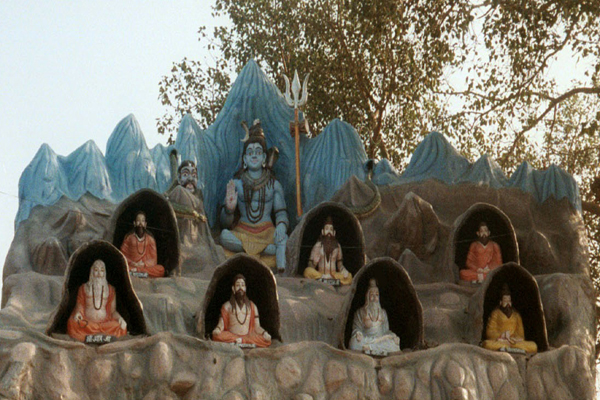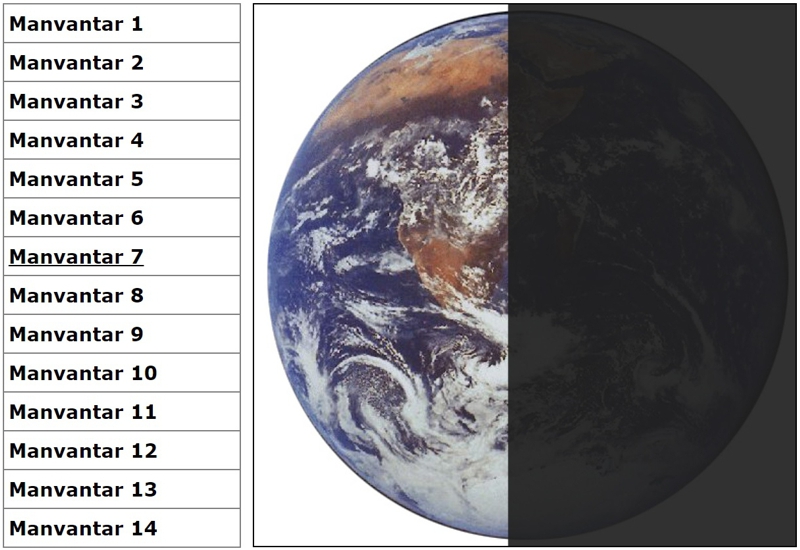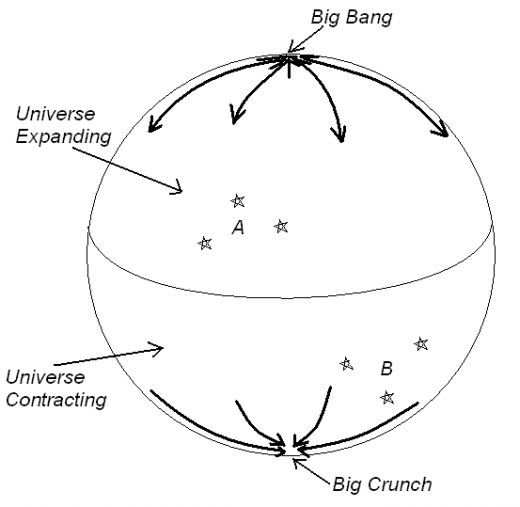
| SAPTARISHIS
Saptarishis The Saptarishis (seven sages) are the seven mind born sons of Brahma. They live for a period of time known as a manvantar (306,720,000 Earth Years). During this period of time they serve as representatives of Brahma.
At the end of a Manvantar the universe gets destroyed and Saptarishis merge in God the task of filling the earth is given to new appointed Saptarishis.
Saptarishis occupy a position higher than that of all other devtas. In addition to the Saptarishis, there are other classifications of Rishis. The major classifications are Brahmarishi, Maharishi and Rajarishi
Brahmarishi :
Brahmarishis
are capable to defeating all human and magical weapons. They are
not influenced by the material world and the cycle of life and
death or karma. They are considered as those who have understood
the meaning of life and all the mysteries of creation.
Manvantar / Manuvantar :
There are two version of Manuvantar the original which is the Sumerian Aryan Version and the Puranic Version. To understand the Sumeriam Aryan Version first we have to study the Sumerian Civilization and after that the Sumerian Aryan Version of Manuvantar.
To know about Sumerian Civilization Click here.
To know about Sumerian Version of Manuvantar Click here.
Manvantar / Manuvantar as per Puran :
Manvantar / Manuvantar or age of a Manu the Hindu progenitor of mankind is an astronomical period of time measurement. Manvantar is a Sanskrut sandhi a combination of words manu and antara, manu-antara or Manvantar literally meaning the duration of a Manu or his life span.
Each Manvantar is created and ruled by a specific Manu who in turn is created by Brahma the creator himself. Manu creates the world and its entire species during that period of time each Manvantar lasts the lifetime of a Manu upon whose death Brahma creates another Manu to continue the cycle of Creation or Shristi, Vishnu on his part takes a new avtar and also a new Indra and Saptarishis are appointed.
Eventually it takes 14 Manus and their respective Manvantars to create a Kalp or a 'Day of Brahma', according to the Hindu Time Cycles and also the Vedic timeline.
Thereafter, at the end of each Kalp there is a period of dissolution or Pralay wherein the world is destroyed and it lies in a state of rest during a period called the 'Night of Brahma'.
After that the creator Brahma starts his cycle of creation all over again in an endless cycle of creation followed by Destruction for which Shiv, Hindu God of destruction and also renewal is invoked towards the end of each such cycle.
Duration of a life cycle :
Brahma is said to have been created from the navel (which is a single point) of Vishnu, described as a lotus blooming out of the navel. The life span of Brahma is of 100 years (day time). During the day Brahma starts the creation process and at night Brahma goes to sleep (only Brahma goes to sleep not Shiv and Vishnu) and during the night all life he created is absorbed back into him. The creation and destruction is an ongoing process (repeated forever).
Brahma creates the universe, the universe maintained by Vishnu (The God of Preservation) and destroyed by Shiv (The God of Destruction). These three constitute the holy Trinity (Trimurti) of the Hindu religion. Once the universe has been destroyed by Shiv, Brahma starts the creation once again. This creation-destruction cycle repeats itself almost endlessly.
The entire time period of the universe is known as Kalp. "Kalp" equals to one day (day + night) of Brahma. Day means the existence period of the universe and night means the destruction period of the universe. The time period of day and night is same.
In the Hindu tradition Ved's were formed in the beginning of the universe. The counting of the time period of the begining of the universe is as following.
One day of Brahma (only day) is divided into 14 parts and each part is known as Manvantar.
Each Manvantar has 71 Chaturyug. Chaturyug is combination of 4 yugs (satyug, tretayug, dwaparyug and kalyug).
One
chaturyug calculation :
The life span of Brahma is of 100 years. Brahma's one day is called a kalp, the creation of Brahma is called vikalp and the creation of the total creation is called mahakalp.
In the Skand Puran, Brahma's thirty days are mentioned as :
Each day of Brahma is a duration of one thousand divya yug's. A divya yug cosists of one thousand of the four yug's. The same duration comprises his night.
Brahmas life span calculation :
The above calculation as per Vishnu Puran :
According to Hindu time calculation year is used according to human years and divya years.
Human years calculation :
Divya
(devta) years and Human years calculation :
According to Bhagwat Puran at present it is Seventh Manvantar. In this 7th Manvantra it is 28th Chaturyugi going on and in this 28th Chaturyugi Satyug, Tretayug and Dwaparyug are overcand at present 4th that is Kalyug is going on.
At present it is first stage of Kalyug. The war of Mahabharat happened in the end of Dwaparyug and Lord Krishna left earth for heaven during the end of Dwaparyug. Around 5000 Years have passed since this incident and it is said that after that the Kalyug started. 5108 years have passed since the beginning of Kalyug.
Each
Manvantar is ruled over by a Manu. In the present Kalp, six Manvantars
have already passed and the names of the six Manus who ruled were
Svayambhuva, Svarochisha, Uttama, Tamasa, Raivata and Chakshusha.
The name of the seventh Manu, who rules over the seventh Manvantar
of the present Kalp, is Vaivasvat.
In the present Vaivasvat Manvantar, the seven great sages are Atri, Vashishth, Kashyap, Gautam, Bharadvaj, Vishvamitra and Jamadagni.
The gods now are the sadhyas, the rudras, the vishvadevas, the vasus, the maruts, the adityas and the two ashvinis.
Manvantar and their Saptarshis :
The exact lists of Saptarishis are not perfectly known as it is supposed that the astral links to the hierarchy were lost in medieval India due to the effects of Muslim invasion on India.
Fourteenth Manvantar according to Bhagwad Puran are :
1. Swayambhu Manvantra :
King Parikshit said to Shukdev, "Gurudev, I just heard that tale of self-begotten Manu's lineage. Now kindly describe to me about the others Manus. Also describe the plays of God's different incarnations which occurred during different Manvantars." Shukdev said, "Parikshit, during Tamas Manvantar, Lord Narayana was born as Hari incarnation from Harini, the wife of a sage. In that incarnation He saved an elephant from the jaws of a crocodile. During the present Kalpa (period comprising the sum of all the four Yug's), six Manvantars have passed. I have described the first one. Now, listen to the description of the other Manvantars."
2. Swarochish Manvantar :
Swarochi Manu was the son of Agni. He had sons named Dyumana, Sushena and Rochismana. During that Manvantar, Indra's post was occuppied by Rochan. Scholars of Ved's like Vrajstambh etc. were among the Saptarishi (seven great sages). Lord had taken incarnation as Vibhu, the son of a sage Vedshira and his wife Tushita. Vibhu remained a loyal celibate lifelong. Following His conduct, eighty-eight thousand more sages observed celibacy life long.
3. Uttam Manvantar :
Third Manu Uttam was the son of the king Priyvrata. He had sons named Pawan, Sanjay, Yagyhotra, etc. In that Manvantar, seven sons of the sage Vashisht were Saptarishi (the seven great sages). Indra's name was Satyajit. Satya, Vedshrut and Bhadra were the main Ganas (courtiers) of the God. God had appeared in the incarnation of Satyasen, the son of Dharma and Sunrita. He was accompanied by Devganas named Satyvrata. Lord had destroyed during that period the evil Yakshas, demon and poltergeists.
4. Tamas Manvantar :
Tamas, the fourth Manu was the real brother of Uttam, the third Manu. He had ten sons. Trishikh was Indra then, with Satyak, Hari, Veer etc. as his main courtiers. Sage like Jyotirdham etc. were the Saptarishi. During that Manvantar Lord had saved Gajendra from the jaws of the crocodile.
5. Raiwat Manvantar :
Raiwas was the fifth Manu. He was also the real brother of Tamas, the third Manu. He had many sons. Vibhu was the name of Indra. Sages like Hiranyroma, Vedshir, Urdhubahm were among Saptarishi. God had appeared in the incarnation of Vaikunth the son of the sage Shubh and his wife Vikunth. At the request of Goddess Laxmi, Lord Vaikunth created Vaikunth dham, the best among all other loks (worlds).
6. Chakshush Manvantar :
Chakshush was the sixth Manu. He had sons named Puru, Purush, Sadyumn etc. Mantrradruma was Indra then, with Apya etc. as main courtiers. Sages like Havishmana and Veeraka etc. were among the Saptarishi. During that Manuantara, Lord had appeared in partial incarnation as Ajit, the son of Vanraj and his wife Sambhunti. It was he who caused the churning of the sea and made the God's drink nectar and supported Mandarachal Mountain on his back in Kachchhap (tortoise) from during the churning.
7. Vaivasvat Manvantar :
Shri Shukdev says, "Parikshit in the present era, the seventh Manu, Shardhdev is the son of Surya. He has ten sons- Ikshvaku, Nabhag, Drisht, Sharyati, Narishyant, Nabhag, Disht, Karush, Prishadhra and Vasuman. Purandar is the name of Indra. He has Adity, Vasu, Rudra, Vishvadev, Marudgan, Ashwini, Kumar and Rishi as his main courtiers. Kashyap, Atri, Vashishth, Vishvamitra, Gautam, Jamadagni and Bhardwaj are the Saptarishi. During this Manvantar, God has arrived in Vamana incarnation as the son of Kashyap and his wife Aditi.
8. Savarni Manvantar :
Savarni, the son of Surya and Chhaya would be the eighth Manu. The king Surath, who had occurred in Swarachish Manvantar, had worshiped Goddess Bhagwadi intensely, and thus received a boon of having an unbroken empire on earth. In later course he will be the son of Surya and become the eighth Manu also. He would have sons like Nirmak, Virajask etc. Vairochana Bali would be Indra, Amritprabha etc. as his main courtiers. Galav, Diptiman, Parashuram, Ashwatthama, Kripachary, Rishyshring and Vyas- these great sages would be the Saptarishi during the eight Manvantar. God would take incarnation as Sarvbhaum, the sons of Devguhya and his wife Saraswati. God as Sarvbhaum would snatch the kingdom of Swarg (heaven) from Purandar Indra and give it to the king Bali.
9. Ninth Manvantar :
Shri Shukdev says, Varun's son Dakshasavarni would be the ninth Manu. He would have sons like Bhutaketu, Diptketu, Dyutiman etc. God would take birth as the incarnation of Rishabh, the son of sage Ayushman and his wife Ambudhara. A person named Adbhut would be Indra and he would have Para, Marichigarbh etc. as his main courtiers.
10. Tenth Manvantar :
Upshloksa's son Brahma Savarni would be the tenth Manu. He would be very pious in nature and have sons like Bhurishen etc. Havishman, Sukriti, Satya, Jay, Murti etc. would be Saptarishi. Shambhu would be Indra, with Suvasana, Viruddh etc. as his main courtiers. God would appear in the incarnation of Vishwasen as the son of Vishwasrij and his wife Vishuchi. He would be a friend of Indra.
11. Eleventh Manvantar :
The self-restraining Dharmasavarni would be the eleventh Manu. He would have ten sons. Vaidhrita would be Indra with Vihangam, Kamagam, etc. as main courtiers. Vedic sages like Arun etc. would be the Saptarishi. God would appear as Dharmasetu, the sons of Aryak and Vaidhrit. In this incarnation he would protect Triloki (all the three worlds).
12. Twelveth Manvantra :
Rudrasavarni would be the twelfth Manu. He would have sons named Devavana, Updev and Devshreshth etc. Ritdhama would be Indra with Hari etc. as his main courtiers. As the son of Satyasahay and his wife Sunrita, the God would protect this Manvantar in the form of Swadham.
13. Thirteenth Manvantar :
Devsavarni would be the thirteenth Manvantar. He would have sons named Chitrasen, Vichitra etc. Divaspati would be Indra of the gods like Sukarm, Sutram etc. Sages like Nirmoka, Tatvadarsh etc. would be the Saptarishi. God would appear as Yogeshwar, the sons of Devhotra and his wife Brihati. He would bestow the designation of Indra to Divaspati.
14. Fourteenth Manvantar :
Indrasavarmi would be the fourteenth Manu. He would have sons like Uru, Gambhir Buddhi etc. Shuchi would be Indra and have Pavitra Chakshush, Etc. as his main courtiers. Agni, Bahu, Shuchi, Magadh etc. would be the Saptarishi. God would appear in the incarnation of Brihadbhahu as the son of Satrayan and his wife Vinata and cause the extension of Karmakand (actions)."
These fourteen Manvantars had continued in past, are continuing in the present and they would continue in the future also. It is by them, that a Kalp (a period of thousand Chaturyug) is completed. Calculation of time is also done through these Manvantars.
Period of a Manvantra is slightly more than seventy one Chaturyug (all the four Yug's passing seventy-one times). A Chaturyug (period of all the four Yug's taken together) lasts for about 3 million years, while a Kalp lasts for about four thousand three hundred and twenty million years. This is equal to a day of Brahma. Brahma's night is Mahapralay (the great deluge). When that night is over, Brahma again begins the work of new creation exactly as per the previous Kalpa. Carrying out this responsibility continuously for a century, Brahma goes back to Bhagwad dham (the abode of Lord Vishnu).
His responsibilities are taken over by the next Brahma, who carries out the work of creation, by the inspiration of Lord Narayan.
Mahapralay (end of 14th Manuvantar) |
||||||||||||||||||||||||||||||||||||||||||||||||||||||||||||||||||||||||||||||||||||||||||||||||||||||||||||||||||||||||||||||||||||||||||||||||||||||||||||||||||||||||||||||||||||||||||||||||||



